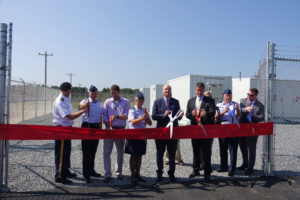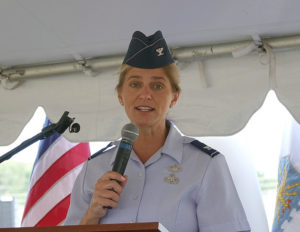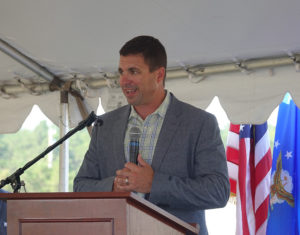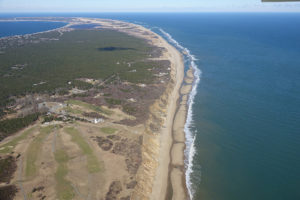 BOURNE – The 102nd Intelligence held a ribbon cutting ceremony Wednesday at Otis Air National Guard Base to celebrate the installation’s newly completed microgrid system.
BOURNE – The 102nd Intelligence held a ribbon cutting ceremony Wednesday at Otis Air National Guard Base to celebrate the installation’s newly completed microgrid system.
The Otis Microgrid project will provide electrical capabilities almost exclusively based on renewable energy while ensuring a high level of security.
“We are all here to celebrate this historic milestone project that will completely transform how the base manages and utilizes energy and will serve as the model for future grid modernization projects,” said Mark Gillard, the 102nd Intelligence Wing Executive Officer.
Along with providing energy resiliency for the 102nd Intelligence Wings’s Intelligence, Surveillance and Reconnaissance Mission, it increases value to the Air Force and National Guard, and state and federal governments through revenue and research opportunities for the energy industry.
The 102nd Intelligence Wing performs vital operations for the U.S. Military and the intelligence community wherever and whenever needed.
The Distributed Ground Station Intelligence Group, DGS Massachusetts, conducts reach back analysis – near real-time – to combatant commanders by sensing data from U-2, RQ-4 and MQ-9 aircraft for tactical operations.
The Cyber-Intelligence, Surveillance and Reconnaissance Group provides unique analysis and awareness of the unique environment of the cyber space domain of battle for cyber mission forces conducting operations and defense of our country.
“The Otis Microgrid provides energy security resilience for these two critical missions all while ensuring a cyber-secure connection to commercial utilities which protects our infrastructure from cyber-vulnerabilities,” said Col. Virginia Doonan, the 102nd Intelligence Wing Commander. “It not only provides energy resilience and security but it is vital to our Wing by ensuring we are of significant value to the United States.”
The Otis Microgrid is the first wind-powered microgrid in the Department of Defense. It is also the first microgrid to support the entire mission of a DoD installation and the first cyber-secure connection to a commercial utility/power grid allowing revenue on investment.
“The financial benefits are estimated to be approximately $600,000 per year through Projected Demand Response Revenues, Capacity Tag Management and Frequency Regulation,” Doonan said. “The significant cost savings further ensures our long-term viability and continued presence in Massachusetts by being a lean, operating Wing and good stewards to the U.S. tax payers.”
The revenue will also allow the Wing to reinvest the savings to further develop and enhance overall infrastructure of the installation.
Doonan said the microgrid was a true collaborative process where multiple stakeholders came together to realize that the completion of the project would provide an opportunity to test new technologies and ensure the cost savings and energy efficiency could be duplicated across the DoD.
The project was funded through a $6 million grant from the Department of Defense.
The state also gifted almost $1 million through military bond bill funds.
Massachusetts Secretary of Energy and Environmental Affairs Matthew Beaton said the project fits in perfectly with many of the initiatives put forward by Governor Charlie Baker over the last few years, including making the state more resilient to the effects of climate change with a strong focus on energy resiliency.
“This project is not only going to serve a tremendous purpose but it is also going to be a model project for us, not only hear in the Commonwealth but across the nation, to follow and learn so many lessons from,” Beaton said. “There is so much done here that is going to help us as we transition into smarter grid and grid modernization efforts throughout the Commonwealth.”
The project included the installation of 3.5 miles of overhead 3-phase electrical cable, 165 utility poles and 4.5 miles of fiber-optic communications cable. There were also 1.5 miles of easement clearance.
More than 300 people from 30 agencies in three countries played a significant role in the completion of the microgrid.
By BRIAN MERCHANT, CapeCod.com NewsCenter


























